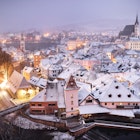

From the amazing streets of Paris in autumn (pictured) to epic islands, here are Europe's best places to visit. Alexander Spatari/Getty Images
There is simply no way to tour Europe and not be awestruck by its natural beauty, fascinating history, rich culture and dazzling artistic and culinary diversity. From sun-smooched islands to secret corners, there's always somewhere new to discover.
Europe’s wealth of attractions is its biggest single draw. Who hasn't dreamed of seeing Florence’s Renaissance art, Venice’s graceful canals, Paris’ Napoleonic splendor, and the multilayered historical and cultural canvas of London? There’s also a huge diversity of natural scenery: rugged Scottish Highlands dotted with glens and lochs; the flower fields and hilltop villages of Provence; the coastlines of the Adriatic and Aegean, speckled with thousands of islands. And those are just the highlights.
Some of Europe's most popular spots have felt the effects of tourism in recent years, as increasing visitor numbers have impacted local populations, services and historic sites. But with a little planning and care, you’re in for the journey of a lifetime. Here are 27 of the best places to visit in Europe.

1. London, UK
Truly one of the world’s greatest cities
London is mercurial and endlessly fascinating. You could spend a lifetime getting to know it, then realize the city has gone and changed again. Stretching back from the mighty River Thames, its lush parks and historic districts are crammed with extraordinary sights: royal palaces, towering cathedrals and remarkable museums and galleries. Add some of the world’s top theaters, restaurants, sports venues and shops, and you’ll be very reluctant to leave.
Travelers who want to dive deeper into London will be rewarded by exploring its varied and characterful neighborhoods, taking in the cool clubs of Shoreditch or the picturesque streets of Notting Hill. With more time, tack on a day trip to explore nature in the New Forest, admire the Roman ruins of Bath, or soak up the creativity of Brighton.
2. Venice, Italy
Magical city seemingly floating on water
A sunny winter’s day, with far fewer tourists around, is the perfect time to lap up Venice's unique and magical atmosphere. Ditch your map and wander the shadowy back lanes of Dorsoduro while imagining secret assignations and whispered conspiracies at every turn. Then visit two of Venice’s top galleries, the Gallerie dell’Accademia and the Peggy Guggenheim Collection, which house works by many giants of Italian and European art.
In recent years, Venice has struggled under the pressures of mass tourism, and visitors should brush up on how to be mindful while traveling in this gorgeous but fragile city. A new entry fee for day-trippers may inspire people to stay longer, which is one way to get a deeper understanding of this incredible place.

3. Paris, France
Get up close to an architectural icon
Designed as a temporary exhibit for the 1889 Exposition Universelle (World Fair), the elegant, iconic Eiffel Tower has become the defining fixture of the Paris skyline. In fact, it’s hard to imagine a city more iconic than the City of Light. From legendary culinary offerings and alluring nightlife to a seemingly endless selection of museums, galleries and flea markets, Paris is a travel dream made real.
Spend your days wandering through the city’s 20 intriguing arrondissements (districts), or head further afield on a day trip to Monet’s garden at Giverny or Marie Antoinette’s former home at Versailles. Whatever you do, it’ll be a trip to remember.
4. Rome, Italy
Classical ruins mixed with contemporary style
From the crumbling Colosseum to the ancient Forum and the timeless Via Appia Antica, few sights are more evocative than the ruins of ancient Rome. Two thousand years ago, this city was the center of the greatest empire of the ancient world, where gladiators battled and emperors lived in unimaginable luxury. Nowadays, its ancient sites have a haunting mystery; as you walk the cobbled paths, you can almost sense the ghosts in the air.
But don’t miss the city’s contemporary side. Shop for hip handbags or handmade jewelry in Rome’s coolest independent boutiques. Rub shoulders with locals over aperitivo (pre-meal drinks) at trendy bars or check out the street art in neighborhoods such as Ostiense and San Lorenzo. In a city that’s been around for thousands of years, there are always plenty of new treasures to find.

5. Berlin, Germany
Catch the ever-changing zeitgeist
Nearly 35 years since the fall of the Berlin Wall, it’s hard to believe that this most cosmopolitan of cities once marked one of the key frontiers in the Cold War. But reminders of Berlin's divided past remain. Whether you’re passing the Brandenburg Gate, gazing at graffiti-covered sections of the old Berlin Wall at East Side Gallery or studying the exhibits at the DDR Museum, it’s an essential part of understanding the forces that have shaped Germany’s capital. From the past to the future – be sure to soak up the city's amazing modern touches, like its iconic club culture, unique independent shops and cool neighborhoods.
6. Dubrovnik, Croatia
A spectacular walled city
Dubrovnik's main claim to fame is its historic city wall, considered among the grandest in the world, which surrounds luminous marble streets and finely ornamented buildings. Built between the 13th and 16th centuries, the walls are still remarkably intact, and the vistas over the terracotta rooftops and the Adriatic Sea are sublime, especially at dusk, when the fading light makes the hues dramatic and the panoramas unforgettable.
The city’s prominent role in the TV series Game of Thrones has caused a massive surge in visitors – and in the number of tours taking people to all the starring spots. But travelers can still get to know the real Dubrovnik by diving deeper into its top attractions and wandering outside of the Old Town.

7. Prague, Czechia
An architectural central European jewel
The capital of Czechia (formerly Czech Republic), Prague is one of Europe’s most alluring and dynamic cities. For all its modern verve, some parts of town have hardly changed since medieval times. Cobbled cul-de-sacs twist and turn, framed by teetering townhouses, baroque buildings and graceful bridges.
If castles are your thing, Prague has an absolute beauty: a 1000-year-old fortress covering around 7 hectares (17 acres) – the world’s largest ancient castle complex. The Old Town is where you’ll find many of the city’s quintessential attractions, but you’ll be rewarded for exploring other intriguing neighborhoods – which also happen to be where you’ll find many of the city's best restaurants.
8. Vienna, Austria
Grand heart of a former empire
The monumentally graceful Hofburg palace whisks you back to the age of empires in Vienna. You can marvel at the treasury’s imperial crowns, the equine ballet of the Spanish Riding School and chandelier-lit apartments once occupied by Emperor Franz Joseph I and Empress Elisabeth. The palace, a legacy of the 640-year-long Habsburg Empire, is rivaled in grandeur only by the 1441-room Schloss Schönbrunn, a Unesco World Heritage Site, and the baroque Schloss Belvedere, both set in exquisite gardens.

9. Amsterdam, Netherlands
World Heritage-listed canals and gabled buildings
To say residents of Amsterdam love the water is an understatement. Take a stroll beside the canals and check out the thousands of houseboats, or take a canal boat ride, and you'll soon understand why. From the water, you’ll notice a whole new set of architectural details, such as the ornamentation bedecking the city's famous bridges. Each time you pass an appealing canalside cafe terrace, mark the location for a later return.
Getting around in Amsterdam is a breeze, making it an ideal city for exploring hip neighborhoods in search of the best things to eat and drink. While there's always plenty to do in Amsterdam, sometimes the best experiences come from slowing down, skipping the tourist sights, and soaking up the city vibe.
10. Budapest, Hungary
Beautiful capital city straddling the Danube
Along both sides of the romantic Danube River, with the Buda Hills to the west and the start of the Great Plain to the east, Budapest is perhaps the most beautiful city in Eastern Europe. Parks brim with attractions, the architecture is second to none, museums are filled with treasures, pleasure boats sail up and down the scenic Danube Bend, Baroque and Turkish-era thermal baths billow steam and the city's nightlife throbs till dawn.

11. Barcelona, Spain
See the genius of a visionary architect
Barcelona is famous for its Modernista architecture, including the iconic buildings of Antoni Gaudí. His masterpiece is the mighty cathedral La Sagrada Família, which remains a work in progress close to a century after its creator’s death. It’s a bizarre combination of crazy and classic – Gothic touches intersect with eccentric experimental flourishes and improbable angles. Even half completed, it’s a modern-day wonder.
Of course, there's much more to the Catalonian capital than its most famous church. Barcelona heaves with tapas restaurants, art museums and history-steeped neighborhoods – not to mention its incredible beaches. The city has been in the spotlight due to the high visitor numbers and the impact on local communities, so make sure you understand the issues before you go.
12. Lisbon, Portugal
Scenic city with soul
The district of Alfama, with its labyrinthine alleyways, hidden courtyards and curving, shadow-filled lanes, is a magical place to lose all sense of direction and delve into Lisbon's soul. On the journey, you’ll pass breadbox-sized grocers, brilliantly tiled buildings and views of steeply pitched rooftops leading down to the glittering Tagus River. Pause at cozy taverns filled with easygoing chatter, with the scent of chargrilled sardines and the mournful rhythms of fado drifting in the breeze, and toast the city with a glass of Portugal's famous port wine.

13. The Scottish Highlands
Scenic grandeur and echoes of the past
Whether you explore on foot, by rail, or on a thrilling road trip, breathtaking views abound in the Scottish Highlands. From the regal charm of Royal Deeside to the brooding majesty of Glen Coe and the mysterious waters of sweeping Loch Ness, these are landscapes that inspire awe. The region is scattered with fairy-tale castles and the hiking is suitably glorious. Add in the Highland hospitality found in classic rural pubs and romantic country hotels, and you're guaranteed to forge memories in this unforgettable corner of Scotland.
14. Dublin, Ireland
Pints of Guinness and literary connections
Whether you’re wandering around the leafy Georgian terraces of St Stephen’s Green or getting acquainted with the past at Kilmainham Gaol or Trinity College, you’re never far from a literary or historic sight in Dublin. Then there are the city’s pubs: there are few better places to down a pint than Dublin. You can even make a pilgrimage to the original Guinness brewery. Either way, you’ll surely make a few Irish friends along the way.

15. Florence and Tuscany, Italy
Renaissance charm and timeless romance
The undulating hills of Tuscany, bathed in golden light and dotted with vineyards, sum up Italy’s attractions in a nutshell. Here, picture-perfect hilltop towns vie with magnificent scenery and some of Italy’s best food and wine. Experiencing Tuscany for the first time is one of Europe's great pleasures. Seek out the famed vintages of Chianti and stroll the evocative main square of historic Siena.
Then there’s Florence – aah, Firenze! – home to what Unesco describes as "the greatest concentration of universally renowned works of art in the world." The Tuscan capital is packed with blockbuster museums, elegant churches and flawless Renaissance streetscapes. Naturally, a city this iconic also heaves with crowds, so make sure you plan your trip around the best times to visit.
16. Copenhagen, Denmark
The cool kid on the Nordic block
Scandinavia is all about pared-back contemporary style – something that the Danish capital has in spades. Home to a thriving design scene, Copenhagen has Michelin-starred restaurants, hipster cafes and bars and swoon-worthy boutiques around every corner. Add in top-class museums and galleries and a 1000-year-old harbor with handsome historic architecture and you have the perfect Scandi city break.
While Copenhagen is known for being expensive, there are ways to budget for your trip and plenty of free things to do in the city. Strolling around and soaking up the atmosphere won't cost you a Danish krone.

17. Andalucía, Spain
Vibrant cities studded with impressive architecture
Andalucía – al-Andalus in Moorish times – is awash with glorious architecture spanning eight centuries of Islamic rule in Spain and all the centuries since. Granada, Córdoba and Seville are the high points of a journey of extraordinary riches. In Granada, the palace complex of the Alhambra comes close to perfection, and is perhaps one of the most impressive works of Islamic architecture anywhere in the world. For many, this is Spain’s signature monument.
18. Ruins of Pompeii, Italy
Ancient city destroyed and preserved by Vesuvius
Frozen in its death throes, the sprawling, time-warped ruins of Pompeii near Naples hurtle visitors 2000 years into the past. Wander through chariot-grooved Roman streets and duck into lavishly frescoed villas and bathhouses, food stores and markets, theaters and even an ancient brothel. Then, in the eerie stillness, with your eye on the ominous profile of Mt Vesuvius, ponder the town’s final hours when the skies grew dark with choking volcanic ash. One of the most intriguing experiences in this ancient city is investigating the ongoing excavations, which continue to shed new light on life in 79 CE.

19. Reykjavík, Iceland
The world’s most northerly capital
More than half of the population of Iceland live in Reykjavík – a city smaller than Anchorage, Alaska – but even on the shortest visit you’ll be struck by the quirky character and creativity of the population. Despite being on the northern margins of Europe, on an island sculpted by volcanoes and ice, locals have forged a city packed with captivating art, rich cuisine and energetic nightlife, hosting an epic music scene. Learn about a history stretching back to Viking times and use the city as a base for trips to Iceland’s amazing natural wonders.

20. Provence, France
Gallic charm in the south of France
For many people, the pastoral landscapes of Provence are a French fantasy brought to life. Provence seems to sum up everything enviable about the French lifestyle: fantastic food, legendary wines, bustling markets and long, balmy evenings, perfect for enjoying the good life. For decades, the villages of Provence have been hot spots for vacationers and second-homers, inspired by a dreamy vision of rustic living.
Seek out the postcard-perfect view of lavender fields and medieval cloisters at the Abbaye Notre-Dame de Sénanque or grab an espresso among the students hanging out in Aix-en-Provence. Whatever you do, eating, drinking and living well will surely be on the menu.
21. Swiss Alps, Switzerland
Hike, ski and admire these postcard-perfect peaks
The stirring ramparts of the Swiss Alps grace chocolate bar wrappers and muesli packets, but nothing prepares you for the magic of seeing these mountains up close. The most famous summit, the Matterhorn, is a mesmerizing wedge of rock and ice that looms above the timber-chalet-filled village of Zermatt. Gaze at it from a tranquil cafe, hike in its shadow along the tangle of alpine paths above town with cowbells clinking in the distance, or pause on a ski slope and admire its craggy, chiseled outline.

22. Istanbul, Türkiye
Where Europe meets Asia
Serving stints as the capital of the Byzantine and Ottoman Empires, Istanbul is one of the world’s great cities, and an ancient crossroads of civilizations. This is true now more than ever with the growing profile of its main international airport. The historical highlights cluster in the district of Sultanahmet – where you'll find the Hagia Sophia, Blue Mosque, Topkapı Palace and Grand Bazaar – with the vast Süleymaniye Mosque crowning a hilltop in Eminönü.
After soaking up Ottoman sights, dive into the city’s characterful neighborhoods, such as cool Kadıköy, with its coffee shops and independent art galleries, or go antique shopping in Fener and Balat. You can even use Istanbul as a base for day trips to explore the wine region of Thrace or the coastal villages of the Black Sea.
23. Athens, Greece
Monument-strewn capital of Ancient Greece
Greece has ancient monuments at seemingly every turn, but it’s in Athens where this ancient empire's greatest and most iconic monuments stand proud. High on a rocky outcrop overlooking the city, the Acropolis epitomizes the glory of ancient Greece, with its graceful Parthenon and 17,000-seat Theatre of Dionysos. Other impressive ruins littering this vibrant city include the Temple of Olympian Zeus and two agoras (marketplaces) – one Greek, one Roman – mingling with first-rate museums.
When you’ve had your fill of architectural magnificence, fill up on Athens’ culinary brilliance, sampling local delights such as lukumades (crisp dough balls) and souvlaki kebabs. The city is also flush with great beaches, and pine-covered islands, atmospheric ancient sites and rugged hiking trails are only a day trip away. Just be alert to the heat – recent years have seen soaring summer temperatures linked to climate change, leading to closures at major sights.

24. Schloss Neuschwanstein, Germany
Fairy-tale castle in a fairy-tale setting
Rising from Alpine foothills in the heart of Bavaria in southeastern Germany, the 19th-century Schloss Neuschwanstein seems to spring from a child’s dream of a fairytale castle. Its pencil-thin turrets, vertiginous walls and glorious setting make it one of Europe’s most recognizable structures – indeed, it was the prototype for the castle in Disney's Cinderella. Rising near Füssen, the castle is at the southern end of the Romantic Road, making it the perfect stop on a beautiful German road trip.
25. Greek Islands, Greece
Whitewashed Mediterranean villages above a turquoise sea
Wherever you make landfall, the Greek Islands grab your attention and don’t let go. Whether you crave beaches, warm seas, history or nightlife, it's easy to find your own island in the sun. It's fair to say that popular islands such as Santorini and Mykonos have suffered under the weight of overtourism, but there are plenty of isles to explore that offer more off-the-beaten-path experiences. Try exploring the lush Ionian Islands or the far-flung Dodecanese. Whichever sun-warmed island you choose, you're in for an incredible experience. Take time to plan the perfect island-hopping adventure and narrow down the islands that are right for you.

26. Ring of Kerry, Ireland
A wild and medieval Irish road trip
There’s nowhere quite like Ireland – and even within Ireland, there's nowhere quite like the Ring of Kerry. This 179km (111-mile) driving route around the Iveragh Peninsula captures all the essential elements of the Republic of Ireland on one memorable circuit. Wild and craggy landscapes frame isolated beaches, evocative ruined fortresses stand sentinel over wave-tossed Atlantic seas, and windswept mountains watch over villages and islands that could be nowhere else on earth but Ireland.
27. Oslo, Norway
Scandinavia’s gateway to the fjords
Oslo is doing everything it can to claim the prize as Europe’s capital of contemporary style, despite facing strong competition from nearby Copenhagen and other Nordic hubs. Oslo's angular Opera House evokes an iceberg in a fjord, public art is a national pastime, and the city’s extraordinary museums span the Viking age to Norway's modern state of contented enlightenment. It's a city to appreciate for its many merits, not merely a stopover on the road to the fjords.

When is the best season to visit Europe?
Europe is a big place – the best time to visit will vary based on the countries you want to see, and your tolerance for heat, cold, and crowds.
Visiting Europe in summer
July and August are undoubtedly the busiest months in Europe, particularly in the most visited countries such as France, Italy, Spain and Greece. In recent years, Mediterranean regions have faced extreme heat and wildfires in the summer months, with popular attractions such as the Acropolis in Athens closing to tourists due to dangerously high temperatures. In France, the south heaves with visitors in the summer, but locals head out on their own summer vacations and many businesses around the country close in August, even in Paris.
Summer can be a great time to visit some of Europe’s cooler, northern regions, such as Scandinavia, where long days and warm temperatures make this a great time for outdoor pursuits – the midnight sun means you can enjoy bright evenings out that last well into the next morning. Across the continent, accommodation prices will be at their highest in summer, and booking well in advance is recommended.
Visiting Europe in spring and autumn
The spring (from April to May) and early autumn (September and October) are both great times to visit Europe, though spring school holidays and Easter vacations can bring crowds, closures and disruptions in many places. Crowds and prices will be smaller than in mid-summer, though destinations such as Italy remain busy throughout the year. Luckily, there are plenty of destinations in Europe that are perfectly suited for an autumn escape or spring break.
Visiting Europe in winter
During the winter months, ski resorts throughout the Alps and other European mountain ranges flood with alpine enthusiasts, and shoppers crowd Christmas markets in major cities, but the cold season can bring closures in spots that depend on summer tourism, including some Greek islands. For a dose of winter sun, many European travelers look to sun-warmed islands such as the Balearics, the Canaries and Malta.

Can I visit multiple countries in Europe during my trip?
With its many land borders, Europe was made for country-hopping – just ask the generations of backpackers and Interrailers who have meandered across it by road, rail and bicycle. How much of Europe you can see in one trip comes down to how much time you have and how packed you want your itinerary to be.
Continental Europe is well-connected by rail, and a resurgence of night trains is making it even easier to get around without the carbon footprint of flying. Travelers can also take the Eurostar train from continental Europe to Great Britain - much less hassle than traveling by plane!
However, be aware of the immigration restrictions that apply to the Schengen Area, which includes most of the countries in continental Europe. If you need to apply for a Schengen Visa, you'll be able to visit multiple European nations within the Schengen Area, but only for a maximum of 90 days within any 180-day period. If you're lucky enough to have a passport from a European Union country, you can travel freely across Europe with few restrictions.
Explore related stories


 Destination Practicalities21 local tips to know before traveling to England
Destination Practicalities21 local tips to know before traveling to EnglandNov 21, 2024 • 9 min read




 Art and CultureCopy my trip: An unforgettable family trip to Spain with Elsewhere by Lonely Planet
Art and CultureCopy my trip: An unforgettable family trip to Spain with Elsewhere by Lonely PlanetNov 19, 2024 • 4 min read


